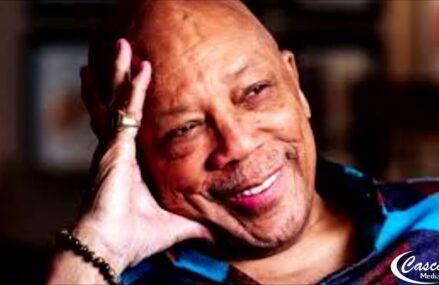Charles Mingus Jr. (April 22, 1922 – January 5, 1979) was an American jazz double bassist, pianist, composer, and bandleader. A major proponent of collective improvisation, he is considered to be one of the greatest jazz musicians and composers in history,[1] with a career spanning three decades and collaborations with other jazz legends such as Louis Armstrong, Duke Ellington, Charlie Parker, Dizzy Gillespie, Dannie Richmond, and Herbie Hancock.
Mingus’ compositions continue to be played by contemporary musicians ranging from the repertory bands Mingus Big Band, Mingus Dynasty, and Mingus Orchestra, to the high school students who play the charts and compete in the Charles Mingus High School Competition.[2] In 1993, the Library of Congress acquired Mingus’s collected papers—including scores, sound recordings, correspondence, and photos—in what they described as “the most important acquisition of a manuscript collection relating to jazz in the Library’s history”.
Charles Mingus was born in Nogales, Arizona. His father, Charles Mingus Sr., was a sergeant in the U.S. Army.[3] Mingus was largely raised in the Watts area of Los Angeles. His maternal grandfather was a Chinese British subject from Hong Kong, and his maternal grandmother was an African-American from the southern United States. Mingus was the third great-grandson of the family’s founding patriarch who was, by most accounts, a German immigrant. His ancestors included German Americans, African Americans, and Native Americans.[4][5][6]
In Mingus’s autobiography Beneath the Underdog his mother was described as “the daughter of an English/Chinese man and a South-American woman”, and his father was the son “of a black farm worker and a Swedish woman”. Charles Mingus Sr. claims to have been raised by his mother and her husband as a white person until he was fourteen when his mother revealed to her family that the child’s true father was a black slave, after which he had to run away from his family and live on his own. The autobiography does not confirm whether Charles Mingus Sr. or Mingus himself believed this story was true, or whether it was merely an embellished version of the Mingus family’s lineage.[7]
His mother allowed only church-related music in their home, but Mingus developed an early love for other music, especially Duke Ellington. He studied trombone, and later cello, although he was unable to follow the cello professionally because, at the time, it was nearly impossible for a black musician to make a career in classical music, and the cello was not yet accepted as a jazz instrument. Despite this, Mingus was still attached to the cello; as he studied bass with Red Callender in the late 1930s, Callender even commented that the cello was still Mingus’s main instrument. In Beneath the Underdog, Mingus states that he did not actually start learning bass until Buddy Collette accepted him into his swing band under the stipulation that he be the band’s bass player.[7]
Due to poor education, the young Mingus could not read musical notation quickly enough to join the local youth orchestra. This had a serious impact on his early musical experiences, leaving him feeling ostracized from the classical music world. These early experiences, in addition to his lifelong confrontations with racism, were reflected in his music, which often focused on themes of racism, discrimination, and (in)justice.[6]
Much of the cello technique he learned was applicable to double bass when he took up the instrument in high school. He studied for five years with Herman Reinshagen, principal bassist of the New York Philharmonic, and compositional techniques with Lloyd Reese.[8] Throughout much of his career, he played a bass made in 1927 by the German maker Ernst Heinrich Roth.
Beginning in his teen years, Mingus was writing quite advanced pieces; many are similar to the Third Stream because they incorporate elements of classical music. A number of them were recorded in 1960 with conductor Gunther Schuller, and released as Pre-Bird, referring to Charlie “Bird” Parker; Mingus was one of many musicians whose perspectives on music were altered by Parker into “pre-and post-Bird” eras.[citation needed]
Mingus gained a reputation as a bass prodigy. His first major professional job was playing with former Ellington clarinetist Barney Bigard. He toured with Louis Armstrong in 1943, and by early 1945 was recorded in Los Angeles in a band led by Russell Jacquet, which also included Teddy Edwards, Maurice Simon, Bill Davis, and Chico Hamilton, and in May that year, in Hollywood, again with Teddy Edwards, in a band led by Howard McGhee.[9]
He then played with Lionel Hampton’s band in the late 1940s; Hampton performed and recorded several of Mingus’s pieces. A popular trio of Mingus, Red Norvo, and Tal Farlow in 1950 and 1951 received considerable acclaim, but Mingus’s race caused problems with club owners and he left the group. Mingus was briefly a member of Ellington’s band in 1953, as a substitute for bassist Wendell Marshall. Mingus’s notorious temper led to his being one of the few musicians personally fired by Ellington (Bubber Miley and drummer Bobby Durham are among the others), after a back-stage fight between Mingus and Juan Tizol.[10]
Also in the early 1950s, before attaining commercial recognition as a bandleader, Mingus played gigs with Charlie Parker, whose compositions and improvisations greatly inspired and influenced him. Mingus considered Parker the greatest genius and innovator in jazz history, but he had a love-hate relationship with Parker’s legacy. Mingus blamed the Parker mythology for a derivative crop of pretenders to Parker’s throne. He was also conflicted and sometimes disgusted by Parker’s self-destructive habits and the romanticized lure of drug addiction they offered to other jazz musicians. In response to the many sax players who imitated Parker, Mingus titled a song “If Charlie Parker Were a Gunslinger, There’d Be a Whole Lot of Dead Copycats” (released on Mingus Dynasty as “Gunslinging Bird”).[citation needed]
Mingus was married four times. His wives were Jeanne Gross, Lucille (Celia) Germanis, Judy Starkey, and Susan Graham Ungaro.[4]



